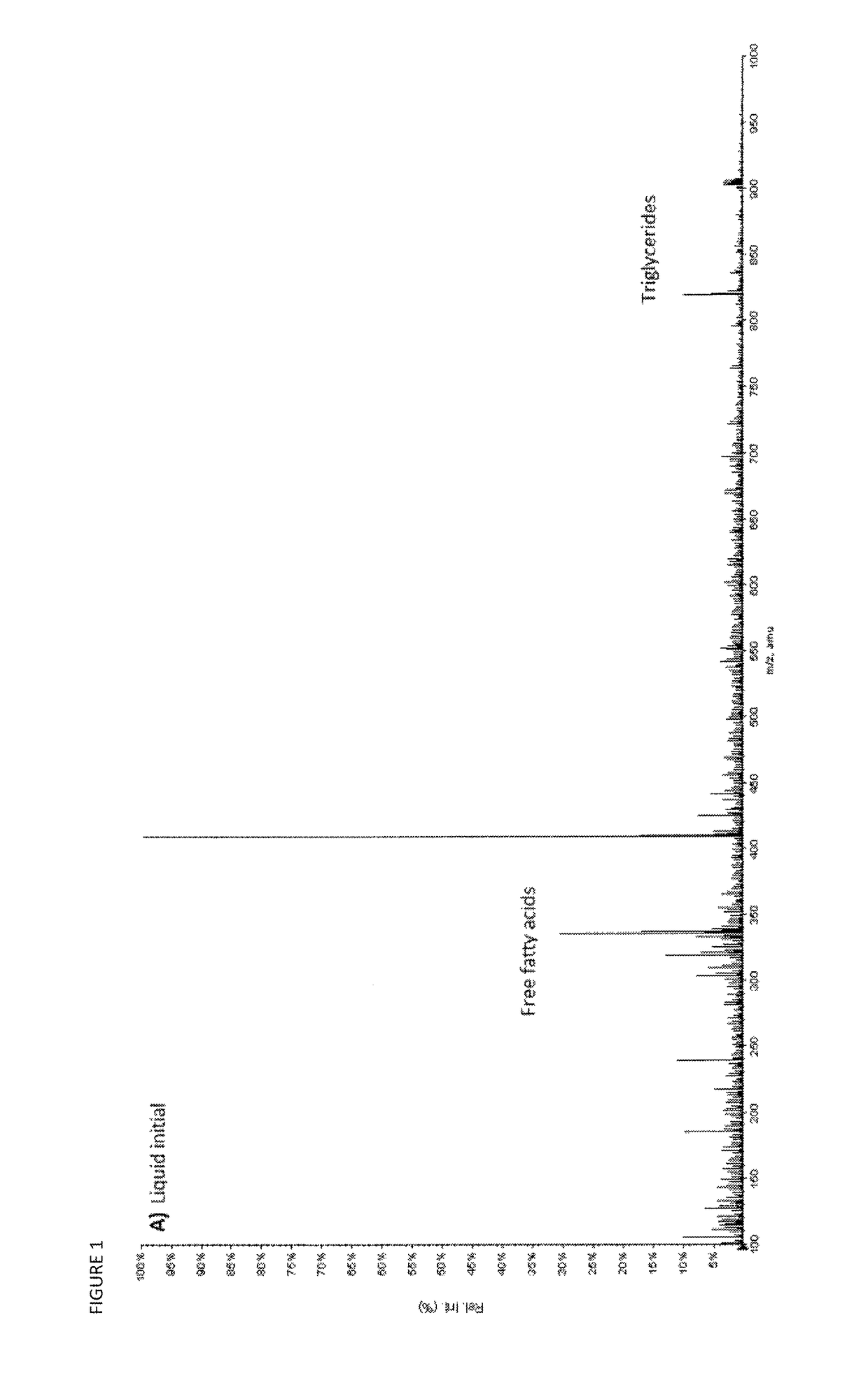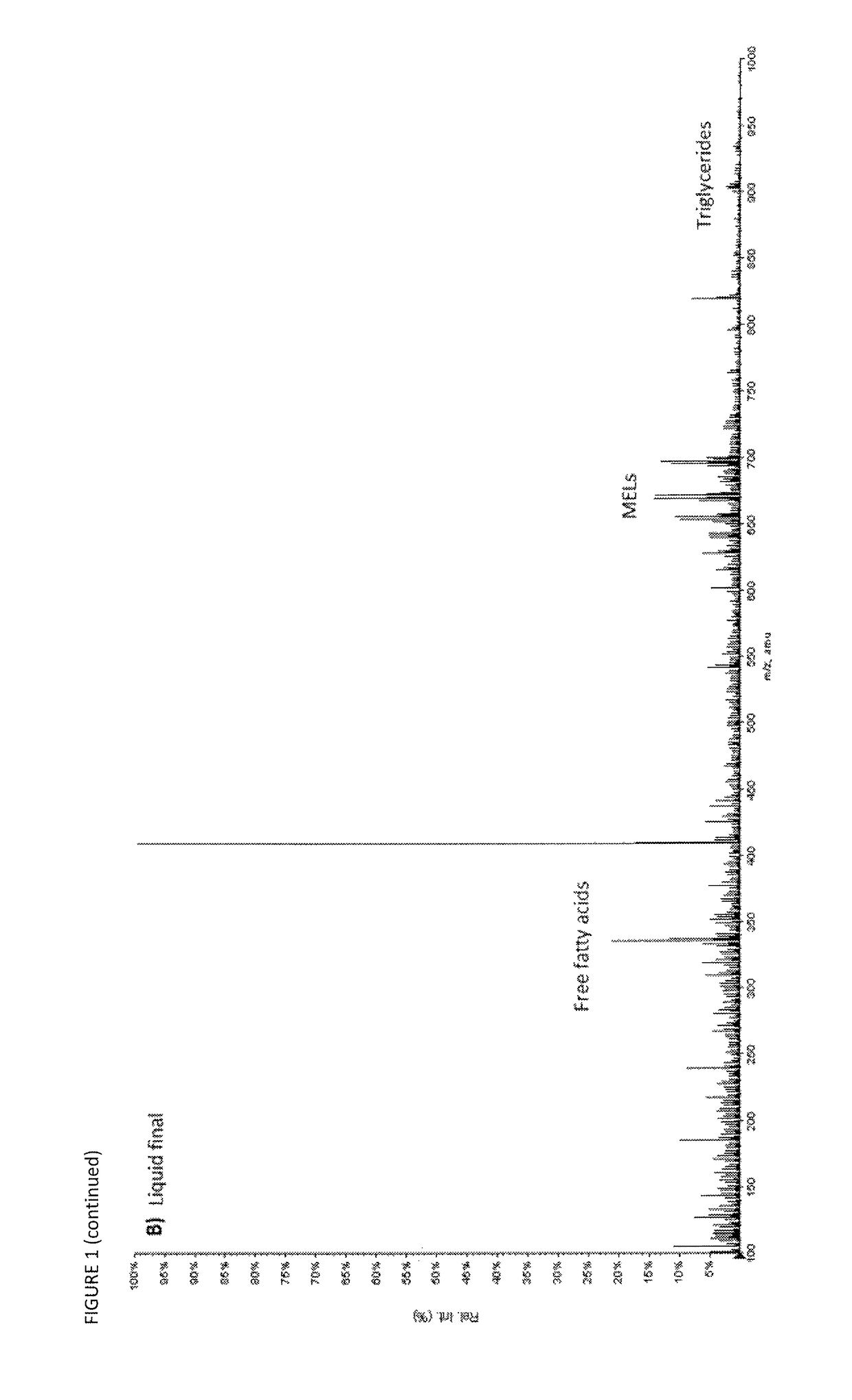Method of separating mannosylerythritol lipids
a technology of mannosylerythritol and lipids, which is applied in the direction of fatty-oil/fat refining, separation processes, bulk chemical production, etc., can solve the problems of no suitable commercially viable method, recent regained attention, etc., and achieve high purity compositions
- Summary
- Abstract
- Description
- Claims
- Application Information
AI Technical Summary
Benefits of technology
Problems solved by technology
Method used
Image
Examples
example 2
[0093]Extraction experiments were carried out on a Thar SFC-1000 extraction rig.
[0094]The support was prepared as follows;
[0095](i) 1.2 kg of support was weighed into a 2 L rotary evaporator flask.
[0096](ii) 300 g of MEL-containing composition was added in 60 g portions.
[0097](iii) The flask was rotated between the additions to completely disperse the MEL-containing composition and the flask was rotated slowly until a free flowing powder was obtained.
[0098]Extraction was then carried out as follows;
[0099](i) The chillers were set at a temperature of 0° C. for the carbon dioxide pump.
[0100](ii) 1.5 kg of the loaded support (powder) was loaded into a 1 L extractor.
[0101](iii) The powder was packed using a plunger to compact the charge and all powder was removed from the inner rim and threads before closing the extractor.
[0102](iv) The carbon dioxide cylinder (ex BOC) was opened, the inline heater and extractor heater were switched off and the separator heated to 45° C.
[0103]A first ex...
example 3
[0108]The MEL-containing composition produced in Example 1 was used with soda lime 3 mm diameter glass beads (ex Paul Marienfeld GmbH & Co.) as support and the procedures described in Example 2 were carried out.
[0109]The separated yields fractions were—liquid carbon dioxide 68.5 wt %, supercritical carbon dioxide 7.2 wt % and supercritical carbon dioxide / co-solvent 12.6 wt %.
(i) Liquid Carbon Dioxide Separation
[0110]FIG. 1 shows the mass spectra of the first and the last liquid carbon dioxide fraction. The free fatty acids and triglycerides are the main compounds appearing in these fractions (M / Z≈300 and ≈900 respectively). Some of the less polar MEL A (M / Zs 669, 695) is beginning to appear towards the end of the liquid step.
(ii) Supercritical Carbon Dioxide Separation
[0111]The evolution of the supercritical extraction can be seen in FIG. 2, where in the initial fractions, the proportion of MELs (M / Z≈600-700) is smaller than in the final supercritical fraction. The free fatty acids ...
example 4
[0113]The MEL-containing composition produced in Example 1 was used with silica gel (60A 40-63 μm, ex Fluorochem LC301SP) support and the procedures described in Example 2 were carried out.
[0114]The silica support exhibited a higher interaction than the glass beads used in Example 3. The separated yields fractions were—liquid carbon dioxide 28.3 wt %, supercritical carbon dioxide 26.5 wt % and supercritical carbon dioxide / co-solvent 26.9 wt %. The MS spectrum (FIG. 4) of the supercritical carbon dioxide / co-solvent fraction shows free fatty acids (M / Z≈300-400) together with MEL A (M / Z 671, 697) and MEL B / C (M / Z 627, 655).
PUM
| Property | Measurement | Unit |
|---|---|---|
| wt % | aaaaa | aaaaa |
| wt % | aaaaa | aaaaa |
| wt % | aaaaa | aaaaa |
Abstract
Description
Claims
Application Information
 Login to View More
Login to View More - R&D
- Intellectual Property
- Life Sciences
- Materials
- Tech Scout
- Unparalleled Data Quality
- Higher Quality Content
- 60% Fewer Hallucinations
Browse by: Latest US Patents, China's latest patents, Technical Efficacy Thesaurus, Application Domain, Technology Topic, Popular Technical Reports.
© 2025 PatSnap. All rights reserved.Legal|Privacy policy|Modern Slavery Act Transparency Statement|Sitemap|About US| Contact US: help@patsnap.com



